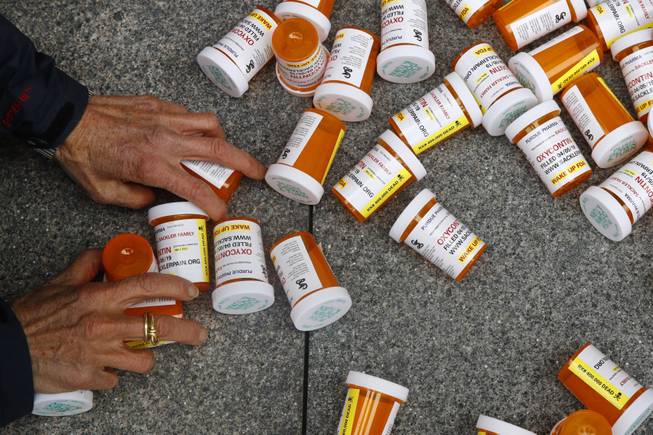
Patrick Semansky / AP
A demonstrator gathers containers that look like OxyContin bottles Friday, April 5, 2019, at an anti-opioid demonstration in front of the U.S. Department of Health and Human Services headquarters in Washington, D.C. This week, Nevada secured a $285 million settlement with Walgreens over the ongoing opioids crisis.
Thursday, June 20, 2019 | 2 a.m.
Marketing, sham medical organizations and funded research exacerbated the opioid epidemic and “created an ecosystem of addiction,” causing the deaths of hundreds of Nevadans and costing thousands of other Nevadans millions of dollars, according to a lawsuit filed this week by the state.
Attorney General Aaron Ford filed the lawsuit Monday in Clark County District Court, targeting multiple pharmaceutical companies and distributors and alleging the defendants pushed a myth that prescription opioids were safe and nonaddictive.
Defendants in the lawsuit include manufacturers such as Teva Pharmaceuticals, Actavis Pharma and Purdue Pharma, and distributors including CVS, Walmart and Walgreens. There are over 40 total defendants, including members of the Sackler family, who own most of Purdue Pharma.
“The defendants created an unprecedented public health crisis for their own profit, and the deaths of thousands of Nevadans is on their hands,” Ford said in a statement. “Their conspiracy to dupe doctors into prescribing more and more deadly and addictive pills has left countless Nevada families and the state suffering in the wake of their greed. Their blatant disregard for human life shocks the conscience. My office will not rest until they pay for the devastation they have caused to our state.”
The opioid epidemic is an inescapable phenomenon, with addiction rates increasing and deaths multiplying from a little over 3,400 in 1999 to over 17,000 in 2017, according to the Centers for Disease Control and Prevention.
So how has this epidemic affected Nevada?
Deaths by overdose
According to the National Institute on Drug Abuse, there were 412 opioid-related overdose deaths in Nevada in 2017. Heroin-related deaths more than doubled between 2012 and 2017 in the state, but the highest number of deaths came from prescription opioids.
According to the lawsuit, there were around 2,800 opioid-related deaths in Nevada between 2010 and 2015.
It is important to note that while prescription opioids caused more deaths than heroin, prescription-related opioid deaths in Nevada have been on the decline overall since 2010.
Opioid prescription rates
According to the Centers for Disease Control and Prevention, Nevada had a higher-than-average rate of opioid prescriptions in 2017 — the last year data is available — compared to other states, with providers writing 73 prescriptions per 100 people. The national average is 58.7 prescriptions per 100 people.
This is the lowest rate in Nevada since the CDC began collecting the data in 2006.
Naloxone use
Naloxone is a medication now widely used to reverse opioid overdose symptoms. The medication is an opioid antagonist, meaning it attaches to opioid receptors in the brain and blocks the effect of an overdose. Between 1996 and June 2014, the CDC reported that, based on available survey data, naloxone had reversed almost 26,500 overdoses nationwide.
The price of the drug has increased as the opioid crisis has spread. For example, Time magazine reported that from 2005 to 2014, Hospira, which was purchased by Pfizer in 2015, increased the list price of its 10-milliliter injectable naloxone pack by 2,300%, from $9 to $220, settling at $158 at the end of 2014, according to data from Truven Health Analytics. During a period from 2014 though part of 2016, naloxone was administered on 1,816 emergency calls throughout Nevada, according to the state Department of Health and Human Services.
Many law enforcement officers in the state, including those with the Nevada Highway Patrol, the Henderson Police Department and some with Metro Police, carry naloxone with them. According to the U.S. Department of Justice's Bureau of Justice Assistance, the cost of a single naloxone intranasal rescue kit to law enforcement agencies ranges from approximately $22 to $60.
Among the most common forms of the naloxone is Narcan, a nasal spray. The lawsuit alleges that in 2016 the Sacklers and Purdue considered selling Narcan. According to the suit, the net revenue from sales of the antidote to overdoses from the same type of opioids that Purdue was selling could grow from $4 million in 2016 to $24 million by 2025. According to the lawsuit, “the Sacklers planned to ‘leverage the current Purdue sales force’ to ‘drive direct promotion to targeted opioid prescribers’ and determined that Purdue could profit from government efforts to use Narcan to save lives.”
Costs
The total annual cost for opioid-related inpatient hospitalizations is difficult to pin down. But using data presented in the lawsuit combined with annual average costs per day for inpatient stays in a state or local government hospital, the potential cost for Nevadans reaches into the hundreds of millions of dollars.
• Between $47.16 million and $72.94 million in 2010 for hospitalizations due to opioids.
• Between $59.4 million and $91.01 million in 2013.
• Between $103.15 million and $159.29 million in 2017.
While the exact number the state has had to pay in regard to the opioid crisis is not fully known, the lawsuit alleges that millions of Medicaid claims have been submitted for “opioid prescriptions for noncancer and nonhospice patients; rehabilitation services for noncancer and nonhospice patients; opioid treatment drugs for noncancer and nonhospice patients; services for Neonatal Abstinence Syndrome for infants born with an opioid dependency; and other prescriptions and/or services arising out of Nevada residents’ opioid use, abuse and dependency.”
